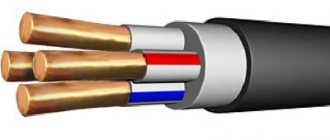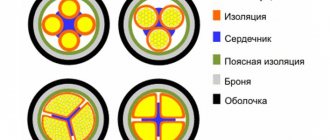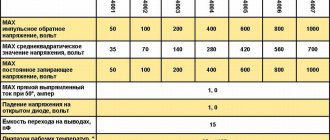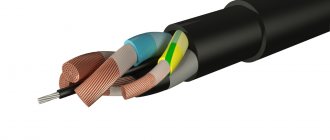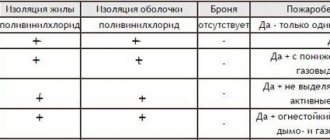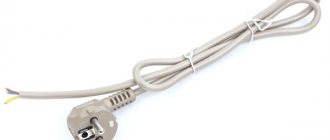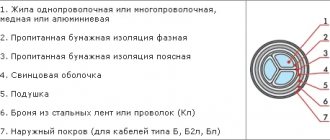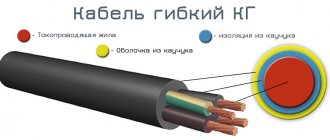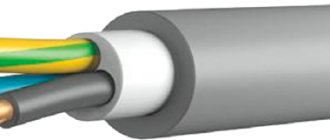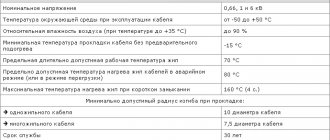KGN power cable is a highly specialized cable product. As the specification states, it is intended for connecting mobile electrical installations to industrial electrical networks - for example, mounted on certain self-propelled mechanisms. Actually, this is a specific variation of the standard CG - a flexible cable with copper conductors, but with its own scope of application.
The KGN wire was originally intended (and is still actively used) for use on river and sea vessels and warships. It uses rubber insulation rather than polyvinyl chloride, which increases the resistance of the wire to waterlogged air, salt water, various oils, disinfectant chemicals and other types of aggressive environments. At the same time, the disadvantage of this wire is its vulnerability to sunlight - under their influence, the rubber coating quickly loses flexibility and begins to decompose.
Explanation of the name
Everything is standard here:
- K - the product belongs to the cable class;
- G - “naked”, that is, without armor, also this letter in the index means flexibility;
- N - nairit. The insulation material used is nairite rubber or, in more modern versions of the cable, butadiene (butadiene-nitrile) rubber. In both cases, the cable markings are the same.
It is important to know:
Nitrile butadiene rubbers, like nairite rubber, are intended primarily to impart oil and gasoline resistance to insulation (as well as resistance to many other aggressive environments), which makes them invaluable in the production of a wide variety of technological products - from wire insulation to technical gaskets , seals and sleeves. At the same time, nairite rubber is inferior in oil resistance to butadiene rubber, but has a number of other useful qualities, for example, resistance to acids and alkalis and combustion resistance.
Advantages and disadvantages of wire
This wire has the following advantages:
- flexibility,
- resistance to aggressive environmental influences,
- possibility of choosing a size depending on the current and voltage characteristics,
- the presence of an insulating layer,
- multi-wire core design, which increases operational reliability.
Among the disadvantages, it should be noted the negative influence of ultraviolet radiation, under the influence of which the rubber coating loses its elasticity, with the possibility of subsequent destruction. Another disadvantage of this cable is the need for additional protection during underground installation.
Design
The KGN type cable is made on the basis of stranded conductors made of tinned tin or a mixture of tin and lead, with a tin content of at least 40%. It has a complex composite structure, which consists of the following elements:
- Stranded conductor of the 5th class of flexibility, round in cross-section.
- Core insulation based on nairite or butadiene rubber (special rubber RTI-1).
- The layer between copper and rubber is made of PET film - polyethylene phthalate, which prevents the insulation from sticking to the copper.
- Surface shell made of polychloroprene rubber RSHN-1.
- A film based on PET or talc that prevents rubber compounds from sticking together between the individual insulation of conductors and the general sheath.
The presence of such intermediate sheaths distinguishes KGN from other types of cables and to some extent increases the cost of this wire, giving it specific characteristics. It can be used in ordinary residential, administrative and industrial areas, in which it is not exposed to aggressive environments, but this is impractical, since there are many cheaper analogues, in particular, the same KG - flexible cable (without special features).
The cores in KGN are twisted, but with a twist pitch not exceeding 16 of their own diameters. In this case, the presence of one or two conductors of a smaller cross-section is allowed (usually “ground” and “zero”). In this case, this fact should be reflected in the marking according to the following example: 3x2.5 + 2x1.5. This means that the cable contains 3 cores with a cross-section of 2.5 mm square, and 2 with a cross-section of 1.5 mm.
The maximum number of conductors in products of this class is 5 (all diameters), the minimum is one conductor. The maximum cross-section is 120 mm square, the minimum is 0.75 mm.
Selection of cable by number of cores and cross-section
The first thing you should focus on when choosing cable products is the operating conditions and permissible loads during data transmission. In the case of household networks with a voltage of 220 V, you can use a cable with two cores, the cross-section of which is 1-6 square meters. mm. If a PE conductor with a grounding loop is used, then you need to select a three-core product. The last core is allocated for grounding.
In electrical networks with voltages of 380 and 660 V, three-core wires are used with a grounding or additional conductor used to control equipment. To calculate the cross-section of conductors, it is necessary to be guided by the current strength and the expected load (power of the connected devices).
The table below shows the maximum permissible current and power depending on the cross-section of two- and three-wire KGN:
| Core cross-section, sq. mm | Current for two-wire KGN, A | Current for a three-wire KGN with “ground” or “zero”, A | Power for two-wire KGN, kW (220 V) | Power for three-wire KGN, kW (380 V) |
| 1,5 | 35 | 27 | 4,1 | 10,5 |
| 2,5 | 47 | 39 | 5,9 | 16,5 |
| 4 | 60 | 49 | 8,3 | 19,8 |
| 6 | 75 | 62 | 10,1 | 26,4 |
| 10 | 97 | 82 | 15,4 | 33 |
| 16 | 128 | 114 | 18,7 | 49,5 |
| 25 | 162 | 148 | 25,3 | 59,4 |
| 35 | 200 | 178 | 29,7 | 75,9 |
| 50 | 245 | 222 | 38,5 | 95,7 |
| 70 | 290 | 272 | 47,3 | 118,8 |
| 95 | 347 | 327 | 57,2 | 145,2 |
| 120 | 407 | 385 | 66 | 171,6 |
If conductors of a smaller cross-section than required for the specified wattage and amperage are used, heating may occur. This will lead to destruction of the insulating layer and failure of the cable.
When purchasing cable products, be sure to perform an external inspection and make sure there are no breaks in the wires or cracks in the insulation. A similar procedure must be carried out after transporting the product or immediately before installation. The homemade dialing method is suitable for this: the testing device is assembled from several simple elements, including a battery, a light bulb and a thin wire.
Sequencing:
- Solder the light bulb to the positive terminal of the battery.
- Solder the wire to the base of the light bulb. The other cable must be connected to the negative side of the battery.
- The remaining ends of the wire must be connected to the edges of the cable being tested. The light should light up, indicating the integrity of the conductor.
- This device is used to test the integrity of core insulation. One end of the tester is connected to the core being tested, the other to the edges of the cable. If the light comes on, this will indicate a short circuit. The cable is unsuitable for use.
Important! If you have a multimeter, checking will be much easier. Set the switch to diode test. Instead of the light coming on, the circuit should close. You will hear a buzzer sound.
Core markings
Multi-wire conductors of KGN type cables can be color or digitally marked. If digital is present, then the insulation of all cores will be the same color, but the following markings will be applied to it:
- 0 - ground;
- 1..5 - neutral and phase conductors.
If the marking is traditional color, then, accordingly:
- EARTH - yellow-green color;
- ZERO - blue;
- PHASE - black, brown, blue.
Red, white, gray, as well as green and yellow, if they are separately, are not used in KGN wires manufactured in accordance with general rules and GOSTs. Thus, their presence is a sure way to identify a fake, or, in any case, it indicates the fact that the cable was produced by a little-known company according to its own specifications. To trust him or not is a personal matter for everyone.
But it is worth noting that the color marking of single- and double-core cables is not regulated in any way. They can be any color.
Classification and price
Various types of KGN are produced according to the number of cores and their cross-sectional area.
In addition to the classic KGN, there are separate types of wire:
- KG-HL - intended for use in cold climates;
- KG-T – tropical variety of products;
- KGVV – wire with polymer insulation, designed for increased service life;
- RKGM – cable products braided from glass fiber with an insulating coating made of organosilicon substances.
Also read: What impact can a transformer booth have on a person?
The cost of a KGN ranges from 25 to 3,000 rubles, depending on the type, number of cores and cable cross-section.
Specifications
The main functional characteristics of the KGN are as follows:
- purpose - for alternating and direct current;
- maximum AC frequency - 400 Hz;
- maximum AC voltage - 660 V, DC - 1000 V;
- operating temperature range of a standard cable, for swimming in temperate latitudes (UHL version) - from –30 to +50 degrees Celsius, in tropical (marked with the prefix T in the name) – from –10 to +55 degrees;
- the maximum permissible heating temperature is +75 degrees;
- minimum installation temperature - up to –15 degrees (that is, the one at which the cable can be laid. If it is lower, it needs to be heated);
- maximum bending radius - 8 outer diameters;
- the construction length depends on the overall cross-section; the smaller it is, the longer the length. So, for example, a wire with a cross-section of 35 mm square will have a construction length of at least 150 mm, but with a total cross-section of 155 mm and above it will be from 100 meters.
The KGN cable is moderately resistant to fire and does not support combustion when laid alone. Despite this, it does not apply to fire-resistant electrical products.
Please note: the bottleneck of this wire is its short validity period. Under the warranty, it is only six months from commissioning, taking into account the production date - no more than 12 months can pass from it. In this case, the actual service life is about two and a half years.
The Western analogue of KGN is NSSHOU cable.
Areas of application and operating conditions
Installation and operation of the KGN cable must be carried out subject to a number of conditions and parameters. Unlike most cable products, KGN is able to withstand exposure to aggressive environments and high humidity. Aggressive environments include, for example, salty sea air or mines, where switching of mobile equipment to electrical power networks is required.
Let us recall that initially the KGN cable was intended for connecting devices on ships. If the installation rules and sequence are followed, the wire can be successfully operated even under water.
Important! Since the design of the KGN does not provide armored protection, it is highly not recommended to lay it underground.
The product is often used as temporary electrical wiring in rooms with natural ventilation. These include various objects located at certain stages of development or basements.
KGN cannot be used on overhead power lines because its shell is not able to withstand the effects of ultraviolet rays from the sun. If such a gasket is necessary, additional protection must be provided for the outer shell.
There are many domestic manufacturers producing cables of this modification. All of them comply with the basic technical requirements, according to which KGN is used for switching non-stationary electrical devices to an alternating current network with a voltage of no more than 660 V and a frequency of 400 Hz, or to direct current sources up to 1000 V. The maximum permissible temperature during continuous operation is 75 degrees. Celsius. The service life of a conventional KGN is 2.5 years, KGN-T - four.
Application area
The main area where it is advisable to use such cables is in rooms with high humidity, where condensation can form on the walls in cold weather (in particular, the internal volumes of sea and river vessels), as well as the so-called machine rooms, the air in which contains vapors of oils and alcohols , gasoline, other caustic chemical compounds, or the cable in some place may come into direct contact with them. Just like the CG, it is used to connect movable electrical mechanisms to stationary current sources.
Description of the KGN cable
You can buy KGN cables of various sections on favorable terms from our company.
We offer low prices on high quality power cables. The proposed type of electrical cable is distinguished by the presence of a non-flammable sheath, resistant to technical oils, made of high-quality rubber. It is intended for use in wet conditions and was specifically developed for the shipbuilding industry.
Manufacturers
In Russia, KGN wire is produced by the following enterprises:
- Kolchuginsky "Electrocable";
- "Kamkabel";
- "Rybinskkabelem";
- "Sevkabelem".
KGN cable is a form of cable and wire products that ensures reliable operation of the line in an aggressive environment with high humidity. Long-term operation of this product is possible if the operating requirements specified by the manufacturer are observed and the correct choice of the number of cores and their cross-section is made, based on the current and voltage parameters and the assigned tasks.
The procedure for a participant to leave and join a group
Any organization can voluntarily withdraw from the KGN, but not earlier than after five years. The company is also obliged to leave the group if it no longer “fits” into the established parameters, for example, when the process of reorganization or liquidation is launched.
If a member leaves the group for any reason, the agreement must be changed. To do this, you must draw up an agreement and register it with the Federal Tax Service. The agreement and supporting documents must be submitted to the tax authorities for registration within one month from the date the participant leaves the group.
If a participant leaves the KGN voluntarily, the changes come into force from the beginning of the next year. If a participant is forced to leave the group due to non-compliance with the requirements of Art. 25.2 of the Tax Code of the Russian Federation, then the agreement is considered to be modified retroactively, i.e. since the beginning of this year.
Important!
After an organization leaves the group, it must calculate its income tax obligations individually for the tax period from the beginning of which its exit was registered.
The UKCG, in turn, must recalculate the group’s tax liabilities taking into account the withdrawal of one of the members. If a new participant has appeared, then you need to submit changing documents to the Federal Tax Service no later than a month before the start of the new tax period.
